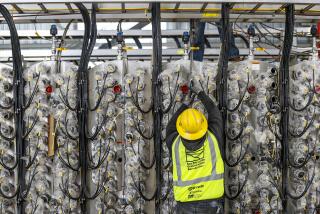Families Embrace Plan to Clean Up Toxic Waste Site : Environment: The EPA schedule calls for residents to move out of their Westminster homes for three months in the spring.
WESTMINSTER — Residents whose homes were built next to one of the nation’s worst toxic waste sites embraced a cleanup plan by the federal government Friday, even though some families will have to move out of their houses while the hazardous waste is dug from the ground.
“We’re very glad something is finally being done to clean this mess up,” said Gloria Delzeith, who has toxic waste oozing up in the back yard of her Sowell Avenue home. “The odor has been tremendous, and it’s made everybody in the family sick for years, including the dogs.”
The U.S. Environmental Protection Agency officially unveiled its plan Friday to excavate the tar-like goo that has plagued the neighborhood. Under the plan, about 25 families will have to leave their homes for three months in the spring while 50-year-old oil refinery sludge, which had been buried in large trenches in their back yards, is removed.
Residents said the inconvenience of temporarily moving out of their homes is nothing compared to the burden of living with a toxic slime that emits an unhealthy, rotten-egg stench.
“It’s really been an ordeal. Leaving for a while won’t be a problem,” Delzeith said.
Delzeith said she suffers from asthma and had two surgeries for a collapsed lung, which she attributes to the toxic waste in her back yard.
EPA officials said the residents will have to move--at the federal government’s expense--because the digging could release dangerous fumes and the heavy construction equipment and holes in the ground would create safety problems. An additional 45 other families within 100 feet of the excavation may also have to move a period of two to three weeks because of the fumes, EPA officials said.
The residents live on Kathy and Allen streets and Sowell Avenue.
Jerrel and Bonnie Haynie, who moved to the middle-class neighborhood about 10 years ago, said they were relieved by the EPA’s plan and don’t mind moving away for a while to get the toxic waste removed from their yard.
“Our lives have been on hold because of this,” Jerrel Haynie said Friday as he walked out to his back yard. “I wanted to build a new fence and build an add-on, but we were told we shouldn’t do that until it was cleaned up.”
The Haynies have several fruit trees in their yard, but have been warned not to eat the peaches and oranges.
“It’s a shame,” Bonnie Haynie said. “We can’t even eat the fruit.”
Farther down Sowell Avenue, Vera Torres said she was pleased that a plan to remove the toxic waste has finally been designed. But even when the waste is gone, she said, the fear will remain.
“You don’t know what kind of long-term effect this has had,” said Torres, who has lived in the neighborhood for 36 years.
EPA officials said no houses will have to be moved or destroyed during the cleanup because the structures were not built directly over the waste. But some added-on patios, family rooms and other structures may have to be removed if toxic material has seeped underneath, they said.
The federal agency will reimburse the homeowners for any damages, and security guards will be provided to patrol the area during the relocation periods.
Under the EPA plan, a contractor will be hired to begin the cleanup in April or May, and continue for one to two years.
The petroleum waste, which contains sulfuric acid, was dumped at the site from about 1936 to the early 1940s. It was later moved and buried in trenches before construction of a housing tract in 1958.
County health officials discovered that the waste was toxic in the early 1980s. The site earned the dubious distinction of being identified as one of the most hazardous toxic sites in the country when it was put on the federal Superfund list in October, 1992.
The costs of the proposed cleanup plan have not yet been determined, authorities said. But because the site is on the Superfund list, the expenses will be paid from a multibillion-dollar pool of taxes and fines on oil companies and other industries.
The EPA will make a final decision on the proposal after hearing from the public. A community meeting will be held at 7:30 p.m. on Sept. 1 at the South Coast College of Court Reporting auditorium, 7122 Maple St. The public may also comment on the proposed cleanup plan during the next 30 days by submitting written comments to the EPA.
More to Read
Sign up for Essential California
The most important California stories and recommendations in your inbox every morning.
You may occasionally receive promotional content from the Los Angeles Times.










